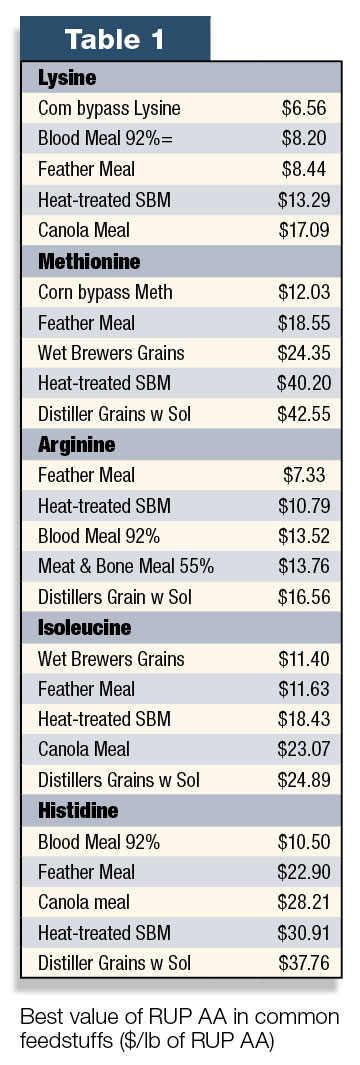“Steve, you gotta take that expensive blood meal out of my mix. That stuff is costing me a fortune,” growled the grizzled dairy farmer whose hair was in little tufts from trying to pull it out while doing the monthly financial books. I had heard it before. I knew the reasoning behind it. If it costs a bunch, it cannot be good.
So I jumped up on my soapbox and told him that sure I could pull the blood, that heavy-laden bypass lysine source feed, out of his diet but then I’d have to raise the crude protein to maintain milk production and we would be overfeeding some amino acids which was just going to lower his nitrogen efficiency, raise his MUN’s and for the cows to get rid of that excess, they would have to burn more energy, converting it to urea and I would have to add more corn or fat to make up for that lost energy – and all that would probably cost him $0.30 to $0.40 per head per day.
I took a breath.
“Is there a cheaper source of bypass lysine?” he asked. I blinked a few times and said something to the effect that it is sure hard to beat blood meal as an amino acid source. But I have to admit, he got me thinking. So I sat down and started to calculate.
Just what was the cheapest source of each bypass amino acid available to my customers? It took some work, OK, a lot of work and I had to make some assumptions in places and I know the money is not accurate to the penny, but I was looking for trends, not absolutes.
Prices change. Qualities vary. The value given to the rumen- undegraded protein (RUP) must also change when the rate of passage changes in the cow. But here is what I figured out and how.
There are 10 essential amino acids that cows (and humans) cannot make and must be consumed in the diet. Most dairy nutritionists agree that lysine and methionine are the two most limiting amino acids in today’s diets. Research shows good milk production, milk protein and butterfat responses when supplemental lysine and methionine are added to the diets to meet the cow’s requirement.
There is a huge debate in the industry regarding which amino acid is the next limiting. Some say arginine, others histidine – and I frequently see isoleucine being deficient in my diets. I think the third-most limiting amino acid is very forage-feeding-program- dependent:
Small-grain forage diets seem to need histidine; high corn silage diets are short in isoleucine, while diets with high legume appear to need arginine. Since these seem to be the most likely five limiting amino acids, I looked at them.
In order to figure the cost per lb of each RUP essential amino acid, I took the price per ton of each common feedstuff/ (2,000 lbs x dry matter percentage x crude protein percentage x RUP percentage x amino acid percentage of RUP). I got the RUP percentage from the CPM modeling program based on 75 lbs of milk with a 3.1 percent milk protein and 52 lbs of dry matter intake for third-lactation cows.
Changing any of these values would change the RUP percentage, so I kept these parameters constant through the entire exercise for each feedstuff.
The amino acid as a percentage of RUP was taken directly from the CPM feedbank. For example, if blood meal cost is $1,100 per ton and is 92 percent dry matter, then that is 1,840 lbs of dry matter x 92 percent crude protein or 1,693 lbs of protein x the RUP percentage predicted by CPM as 85 percent or 1,439 lbs of bypass protein, of which 9.3 percent is lysine; you end up with 134 lbs of bypass lysine per ton of blood meal. This results in a RUP lysine valued at $8.20 per lb ($1,100 per 134 lbs) for blood meal. The lower the value, the cheaper it is to meet the amino acid requirement.
I looked at corn, SBM, distillers, whole fuzzy cottonseed, roasted beans, wet brewers, wet distillers, canola, wheat midds, cottonseed meal, heat-treated SBM, meat and bone meal, corn gluten meal and feed, blood meal, feather meal and commonly fed commercial bypass lysine and methionine sources.
I have just listed the top five and here are the values I found for my five limiting amino acids in Table 1.

The lysine calculation finds that the commercially available forms of bypass lysine are the most economical sources at $6.56 per pound of RUP lysine.
These prices range from $6.56 per lb all the way up to $548 per lb for corn gluten feed’s bypass lysine. This is not to say corn gluten feed is a bad feed, just a poor choice to add bypass lysine to a diet – there are many cheaper ways of doing that.
I realize that many will disagree with my final numbers. Again, they are not exact; I was just looking for trends. You may quickly argue that my blood meal example is all wet. Sure, dry matters change a couple of points and we all know there is a huge range of crude proteins in the marketplace.
I have personally tested everything from 80 percent crude protein to some really high-quality sources at 99 percent. With these crude protein differences come different RUP percentage values and I did not look at digestibility at all.
Since we are talking blood meal, I recently ran into a breeder in a pen of cows and he grinned to me and asked why I had quit feeding blood meal on this farm. I was a bit curious and asked him how he knew I had quit.
He simply pulled his glove out and spread his fingers and said he did not see the blood meal on his gloves anymore. Poor-digesting stuff to say the least. Ironically, I had noticed the blood meal in the manure screen a month earlier and had a discussion with the local feedmill about their blood meal quality and they had changed suppliers.
The cows responded with three pounds of milk with the increased available RUP lysine and the blood meal disappeared from the manure and the glove. So changing either your crude protein or your RUP percentage will change the final numbers.
I gave you the formula so you can run your cost per lb with your blood meal’s numbers. If you want to add digestibility just multiply the 134 lbs of RUP lysine by your digestibility number and have at it.
Just because a certain feed ingredient is expensive should not be the deciding factor to remove it from the cow’s diet. Ask why we are feeding this ingredient and how cheaply does it meet our nutritional goals.
Finding the least-cost price or best value for any nutrient may give you insight into why an ingredient should stay in the diet. Blood meal at $1,100 per ton may seem expensive per cow per day, but blood meal is currently one of the better buys we have for bypass lysine. In fact, blood meal works out to be a great buy for seven of the 10 essential amino acids, making it even more valuable to the cows, the banker and the dairyman. PD

-
Steve Massie
- Western Field Nutrtionist
- Renaissance Nutrition
- Email Steve Massie








